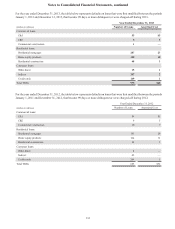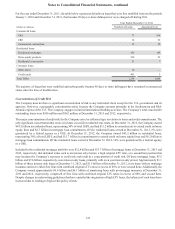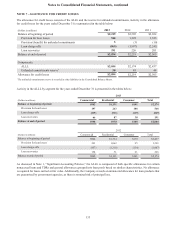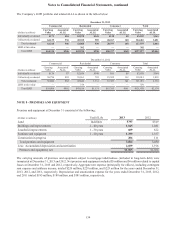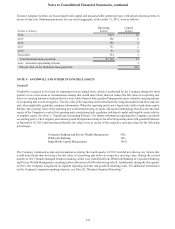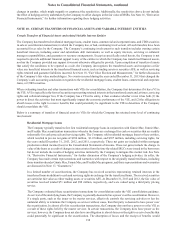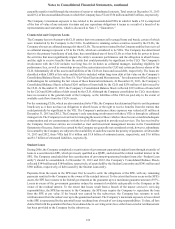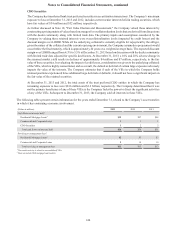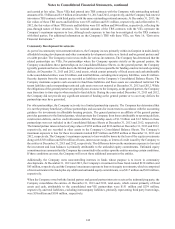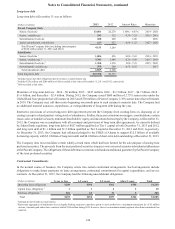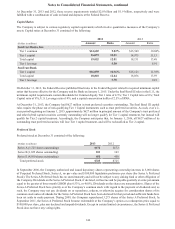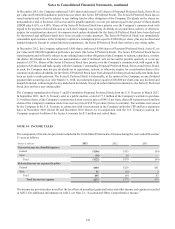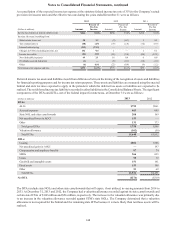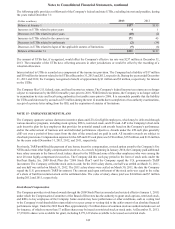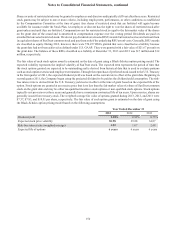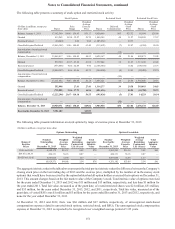SunTrust 2013 Annual Report Download - page 157
Download and view the complete annual report
Please find page 157 of the 2013 SunTrust annual report below. You can navigate through the pages in the report by either clicking on the pages listed below, or by using the keyword search tool below to find specific information within the annual report.
Notes to Consolidated Financial Statements, continued
141
Portfolio balances and delinquency balances based on accruing loans 90 days or more past due and all nonaccrual loans at
December 31, 2013 and 2012, and net charge-offs related to managed portfolio loans (both those that are owned or consolidated
by the Company and those that have been transferred) for the year ended December 31, 2013 and 2012 are as follows:
Portfolio Balance1Past Due2Net Charge-offs
December 31,
2013
December 31,
2012
December 31,
2013
December 31,
2012
Year Ended
December 31
(Dollars in millions) 2013 2012
Type of loan:
Commercial $64,310 $58,888 $272 $320 $153 $303
Residential 43,190 43,199 1,296 1,941 444 1,285
Consumer 20,377 19,383 631 68 81 93
Total loan portfolio 127,877 121,470 2,199 2,329 678 1,681
Managed securitized loans:
Commercial 1,617 1,767 29 23 ——
Residential 100,695 104,877 493 32,186 323 30
Total managed loans $230,189 $228,114 $2,721 $4,538 $701 $1,711
1Excludes $1.7 billion and $3.4 billion of LHFS at December 31, 2013 and 2012, respectively.
2Excludes $17 million and $38 million of past due LHFS at December 31, 2013 and 2012, respectively.
3Excludes loans that have completed the foreclosure or short sale process (i.e., involuntary prepayments).
Other Variable Interest Entities
In addition to the Company’s involvement with certain VIEs related to transfers of financial assets, the Company also has
involvement with VIEs from other business activities.
Total Return Swaps
The Company has involvement with various VIEs related to its TRS business. Under the matched book TRS business
model, the VIEs purchase assets (typically commercial leveraged loans) from the market, which are identified by
third party clients, that serve as the underlying reference assets for a TRS between the VIE and the Company and a
mirror TRS between the Company and its third party clients. The TRS contracts between the VIEs and the Company
hedge the Company’s exposure to the TRS contracts with its third party clients. These third parties are not related
parties to the Company, nor are they and the Company de facto agents of each other. In order for the VIEs to purchase
the reference assets, the Company provides senior financing, in the form of demand notes, to these VIEs. The TRS
contracts pass through interest and other cash flows on the assets owned by the VIEs to the third parties, along with
exposing the third parties to depreciation on the assets and providing them with the rights to appreciation on the
assets. The terms of the TRS contracts require the third parties to post initial collateral, in addition to ongoing margin
as the fair values of the underlying assets change. Although the Company has always caused the VIEs to purchase a
reference asset in response to the addition of a reference asset by its third party clients, there is no legal obligation
between the Company and its third party clients for the Company to purchase the reference assets or for the Company
to cause the VIEs to purchase the assets.
The Company considered the VIE consolidation guidance, which requires an evaluation of the substantive contractual
and non-contractual aspects of transactions involving VIEs established subsequent to January 1, 2010. The Company
and its third party clients are the only VI holders. As such, the Company evaluated the nature of all VIs and other
interests and involvement with the VIEs, in addition to the purpose and design of the VIEs, relative to the risks they
were designed to create. The purpose and design of a VIE are key components of a consolidation analysis and any
power should be analyzed based on the substance of that power relative to the purpose and design of the VIE. The
VIEs were designed for the benefit of the third parties and would not exist if the Company did not enter into the TRS
contracts with the third parties. The activities of the VIEs are restricted to buying and selling reference assets with
respect to the TRS contracts entered into between the Company and its third party clients and the risks/benefits of
any such assets owned by the VIEs are passed to the third party clients via the TRS contracts. The TRS contracts
between the Company and its third party clients have a substantive effect on the design of the overall transaction and
the VIEs. Based on its evaluation, the Company has determined that it is not the primary beneficiary of the VIEs, as
the design of the TRS business results in the Company having no substantive power to direct the significant activities
of the VIEs.
At December 31, 2013 and 2012, the Company had $1.5 billion and $1.9 billion, respectively, in senior financing
outstanding to VIEs, which was classified within trading assets and derivatives on the Consolidated Balance Sheets


